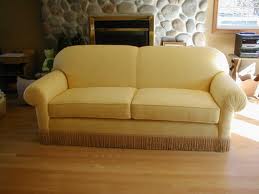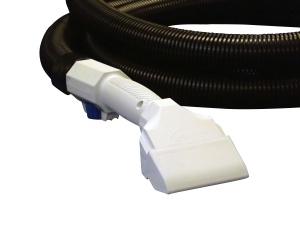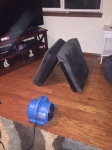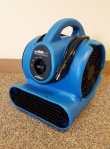Why Do We Clean Upholstery?
 The reasons may vary from company to company:
The reasons may vary from company to company:
- Our carpet cleaning customers expect it of us.
- We do not have to develop the market. Our carpet cleaning customers often ask us or expect us to be able to clean their upholstery
- Properly trained, we can make good money at it.
According to two different industry surveys, people who have had their carpet cleaned by a professional said that upholstery cleaning was the “add-on” service that the technician most often tried to sell to them. Why would upholstery cleaning be the most likely “add-on sale”? It is an “easy” sale, and the customer expects us to be able to do it!
But I want you to think about that for a minute. Think about all of the other service menu items your company could offer as an “add-on sale?”
- Fabric protection
- Tile & Grout cleaning
- Pressure washing
- Restorative cleaning for stone surfaces
- Wood floor recoating and renovation
- Rug cleaning
The diversification choices available to the professional carpet cleaning contractor are wide and varied. Yet upholstery cleaning is the most likely “add-on” service most are likely to offer. Now compare upholstery cleaning to other add-on services. Isn’t upholstery cleaning one of the highest risk and potentially the lowest profit margin add-on service we provide? The truth is that most upholstery is easy to clean. What should stop us in our tracks though is the fact that the very small risk of cleaning an upholstered piece that does not res pond to cleaning properly still exposes us as cleaners to a very large potential loss.
pond to cleaning properly still exposes us as cleaners to a very large potential loss.
Is upholstery cleaning really that complicated? Preview the technical talk that you may have learned about related to upholstery cleaning for just a moment. These are all things we may encounter when cleaning upholstery
(1) Weaves
(2) Textures
(3) Cellulosic man-made fibers
(4) Polymer based synthetic fibers
(5) Natural fibers
(6) Multiple layers of fabric
(7) Incorrect cleaning codes
(8) Unstable dyes/coloring
(9) Thoughtless manufacturing techniques
(10) Fabric manufacturer ignorance (marking the foam underneath with a permanent marker whose ink may transfer when the outside fabric gets wet qualifies as one example to me)
What should our attention is that fact that occasionally when we clean a lot of upholstery; we get “caught.” You can do everything “right” and still have something go very wrong. You can do what you are taught to do, in accordance with industry standards of cleaning, and still have the upholstered fabric respond in a negative way. If you clean enough upholstery, you will eventually have to “buy” a piece when that happens. You can have all of the liability waivers and pre-inspection forms in the world, but eventually you will have a situation where re-covering or buying the couch is less expensive than a long drawn out fight with a customer. You either need to make sure you have the right kind of insurance coverage to help you in this situation, or you need to charge enough and set enough money aside to deal with this when it happens. Preferably you should do both. But there-in lays another challenge.
The increased “value” (price) needed to justify the time and effort it will take your company to clean the piece safely and correctly (in accordance with industry standards of care) isn’t always manifest in the perceived “value” the furniture has to your customer. How is the “value” defined or determined? Did they purchase the sofa from a high end furniture retailer for thousands of dollars, or is it a “hand me down” sofa from Aunt Edna they got for free?
Do not kid yourself! It is true that almost every stitch of fabric out there can be cleaned, BUT not everyone wants to pay you enough to do the pre-testing, and follow the right cleaning procedures in cleaning it. You may have to learn how to say “NO, THANK YOU!” Just because we can clean a certain piece of upholstery doesn’t mean we should clean that piece of upholstery!
Now there are some really unique upholstered fabrics out there that can’t be cleaned and that you would be best to walk away from. Some fabrics are just plain not cleanable, by any method, using any system! The truth is though…that most upholstery cleaning related problems are caused by us – when we overwet the fabric and/or use too aggressive of a pH in our cleaning chemistry.
What are some of the basic differences between cleaning carpet and cleaning upholstery?
- “Thickness” of the fabric. Upholstery is a thin fabric. Carpet is a much heavier textile.
- Layers – some upholstered fabric has more than one fabric in its construction.
- Construction – upholstery is most often a woven fabric. Carpet is usually a tufted textile.
- What’s behind it? Carpet has a pad or cushion and usually a wood or concrete subfloor. Upholstery has foam cushion and the wood, metal or plastic framework of the furniture.
What are the basic differences in soiling conditions between carpet and upholstery? Upholstery is most affected by the following types of soil:
- Skin and body oils
- Dead skin
- Hair treatments/sprays
- Airborne oils
- Pet hair
- Food and beverage spills
- Skin lotions and treatments
The Goal of Upholstery Cleaning
As you learn more about how upholstery is constructed, you will learn about fiber content, weaves, finishes, and construction of fabric. Any or all of these components can have an effect on the cleaning process. You have to be concerned about the quality of your cleaning results (usually appearance improvement); shrinkage; browning; yellowing; weak or fugitive dyes that may bleed; spots and stains; and change in the texture of the fabric.
Your expertise in carpet cleaning gives you an excellent base knowledge to help you out when cleaning upholstery, but it does not make you expert upholstery cleaner. One reason for this is that with carpet you are dealing with only a few fibers or blends, and there are only a few basic methods of carpet construction. In furniture cleaning, the fibers, blends, and construction of the fabric is much more varied, in fact most upholstery fabrics are blends of more than one fiber.
You will have to be aware of many more possibilities when cleaning upholstery than with carpet. Where carpets are tougher and meant to handle years of abuse, most furniture fabrics are delicate and designed for their decorative effect rather than their durability and cleanability. We say this not to scare you, but to make you aware that a little added expertise is required to handle most of today’s furniture fabrics. When it comes to pre-testing and cleaning upholstery, you have one main goal: remove as much soil as possible, without changing the color or texture of the fabric. If you forget this, and you are too aggressive, you may find yourself in a situation that is difficult to correct.
Three rules to successful and safe upholstery cleaning
It is important to know that you can clean a fabric successfully without knowing the exact fiber if you follow the basic rules of cleaning, and if you TEST your cleaning method to be sure that it is safe for that piece. Pretesting is important because it provides useful information about dyes, finishes, and construction. Three of the most important rules you can remember in cleaning upholstery are:
Control your moisture – Many cleaning related problems are directly related to over- wetting. You should always avoid overwetting. Use the proper tools and cleaning procedures and you can avoid most of these problems. This is where the HydraMaster DriMaster 3 Upholstery tool can make a HUGE difference. With the DriMaster 3 Upholstery Tool, the cleaning solution is applied in a thin, flat fluid stream for even application. The constant solution flow is trained by the patented injector bar and slotted vacuum port system, which means there is no spray jet to clog. The cleaning solution shears across the fabric rather than directly spraying into it, which greatly minimizes the likelihood of over-wetting the fabric. In addition, the immediate vacuum recovery of solution flow means less residual moisture, which leaves the fabric cleaner and dryer.
wetting. You should always avoid overwetting. Use the proper tools and cleaning procedures and you can avoid most of these problems. This is where the HydraMaster DriMaster 3 Upholstery tool can make a HUGE difference. With the DriMaster 3 Upholstery Tool, the cleaning solution is applied in a thin, flat fluid stream for even application. The constant solution flow is trained by the patented injector bar and slotted vacuum port system, which means there is no spray jet to clog. The cleaning solution shears across the fabric rather than directly spraying into it, which greatly minimizes the likelihood of over-wetting the fabric. In addition, the immediate vacuum recovery of solution flow means less residual moisture, which leaves the fabric cleaner and dryer.
Control your pH – Too high of pH can cause bleeding, browning, and other types of problems. Most times you will be using a mild alkaline, and at times a neutral or even an  acid chemical may be needed. In addition, remember that the soil you are trying to clean from upholstery is quite different than typical carpet soil. Review the list above. HydraMaster has formulated a line of cleaning solutions that are specifically designed to safely and effectively clean the various types of upholstery you will encounter. Check out the complete line here.
acid chemical may be needed. In addition, remember that the soil you are trying to clean from upholstery is quite different than typical carpet soil. Review the list above. HydraMaster has formulated a line of cleaning solutions that are specifically designed to safely and effectively clean the various types of upholstery you will encounter. Check out the complete line here.
Speed up your drying – Most problems occur during the drying step, not instantly. By reducing the dry time of the fabric, you will greatly reduce the chance of bleeding, browning, or wicking. An air mover can be your best friend in cleaning upholstery. A
 smaller, lightweight airmover will be more likely to be carried into your customer’s homes by your technicians and are small enough the airflow can be directly applied to the upholstery and its cushions. The HydraMaster HM1000 Epic Micro Airmover works perfectly for this and costs a great deal less than conventional airmovers.
smaller, lightweight airmover will be more likely to be carried into your customer’s homes by your technicians and are small enough the airflow can be directly applied to the upholstery and its cushions. The HydraMaster HM1000 Epic Micro Airmover works perfectly for this and costs a great deal less than conventional airmovers.
For more information about the most effective ways to clean upholstery, you can download our FREE cleaning app for your smartphone, tablet or computer. If you would prefer something more conventional, feel free to download our free cleaning procedures guide for upholstery you can print out here.
Tags: construction of fabric, DriMaster, Drimaster Upholstery Tool, fiber content, finishes, pH, pH upholstery, weaves





